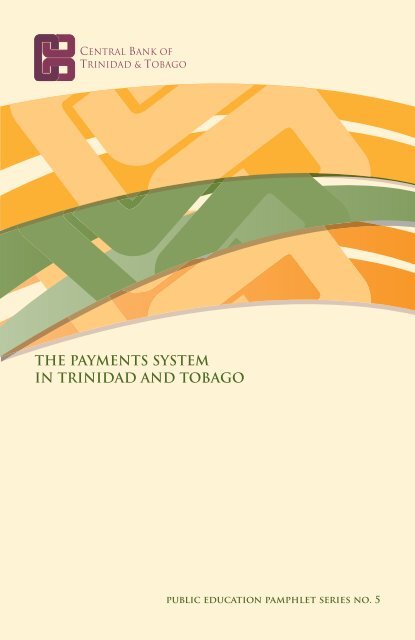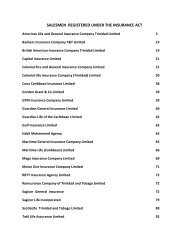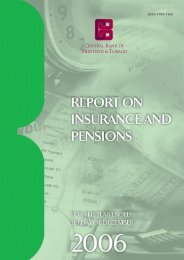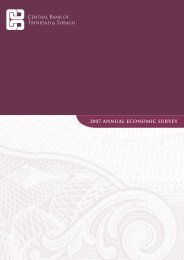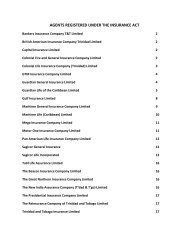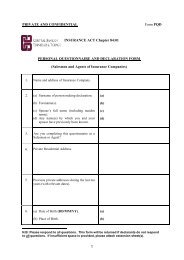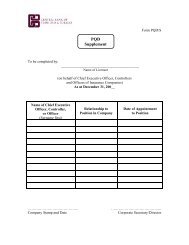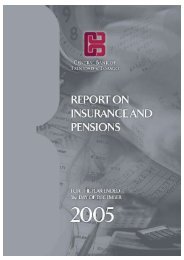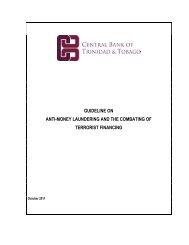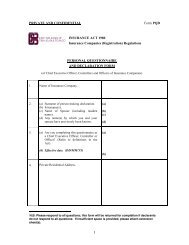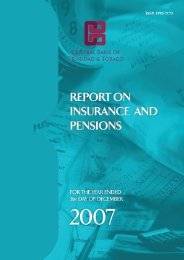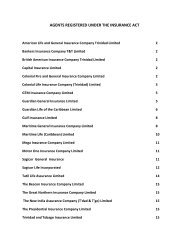the payments system in trinidad and tobago - Central Bank of ...
the payments system in trinidad and tobago - Central Bank of ...
the payments system in trinidad and tobago - Central Bank of ...
You also want an ePaper? Increase the reach of your titles
YUMPU automatically turns print PDFs into web optimized ePapers that Google loves.
THE PAYMENTS SYSTEMIN TRINIDAD AND TOBAGOpublic education pamphlet series no. 5
public education pamphlet seriesISSN 1817-3160ACKNOWLEDGEMENTSThe <strong>Bank</strong> wishes to acknowledge <strong>the</strong> contributions <strong>of</strong>Mr. Osborne Nurse <strong>and</strong> Dr. Ronald Ramkissoon, whomade useful <strong>and</strong> valuable suggestions for thispublication.All rights reserved.No part <strong>of</strong> this publication may be reproduced <strong>in</strong> any form or o<strong>the</strong>rwise without<strong>the</strong> written permission <strong>of</strong> <strong>the</strong> <strong>Central</strong> <strong>Bank</strong> <strong>of</strong> Tr<strong>in</strong>idad <strong>and</strong> Tobago.ISBN:978-976-8134-12-7© <strong>Central</strong> <strong>Bank</strong> <strong>of</strong> Tr<strong>in</strong>idad <strong>and</strong> Tobago, October 2009
FOREWORDExternal communications are an important part <strong>of</strong> <strong>the</strong> bus<strong>in</strong>ess<strong>of</strong> <strong>the</strong> <strong>Central</strong> <strong>Bank</strong> <strong>of</strong> Tr<strong>in</strong>idad <strong>and</strong> Tobago. The <strong>Bank</strong>’s outreach<strong>in</strong>itiatives are <strong>in</strong>tended both to enhance its contribution to educat<strong>in</strong>g<strong>and</strong> <strong>in</strong>form<strong>in</strong>g <strong>the</strong> public generally, as well as to assist markets <strong>in</strong>underst<strong>and</strong><strong>in</strong>g <strong>the</strong> <strong>Bank</strong>’s policy actions <strong>and</strong> <strong>in</strong>tentions.In addition to <strong>the</strong> regular publications <strong>of</strong> its Research Department,<strong>the</strong> <strong>Bank</strong>’s Outreach Programme has <strong>in</strong>cluded lectures <strong>and</strong>speeches to school children by senior <strong>Bank</strong> <strong>of</strong>ficials, mentor<strong>in</strong>g toundergraduate students <strong>and</strong> support<strong>in</strong>g an <strong>in</strong>ternship arrangementwith <strong>the</strong> University <strong>of</strong> <strong>the</strong> West Indies.This public education series is also a part <strong>of</strong> <strong>the</strong> Programme.Its <strong>in</strong>tention is to provide <strong>in</strong>formation on topics <strong>and</strong> policies thatare relevant to <strong>the</strong> management <strong>of</strong> <strong>the</strong> economy <strong>of</strong> Tr<strong>in</strong>idad<strong>and</strong> Tobago. The world <strong>of</strong> bus<strong>in</strong>ess <strong>and</strong> trade is a fast-paced,ever-chang<strong>in</strong>g <strong>and</strong> challeng<strong>in</strong>g one <strong>and</strong> <strong>the</strong> tools <strong>of</strong> knowledge <strong>and</strong><strong>in</strong>formation must be strategically used to navigate it.This pamphlet series is geared towards a broad readership. Itis likely to be a good source <strong>of</strong> <strong>in</strong>formation for students at <strong>the</strong>secondary <strong>and</strong> tertiary levels, pr<strong>of</strong>essionals <strong>and</strong> o<strong>the</strong>r members<strong>of</strong> <strong>the</strong> public who are <strong>in</strong>terested <strong>in</strong> <strong>in</strong>creas<strong>in</strong>g <strong>the</strong>ir knowledge <strong>of</strong>economics <strong>and</strong> bus<strong>in</strong>ess.Each pamphlet will cover current <strong>and</strong> topical issues <strong>and</strong>expla<strong>in</strong> new economic <strong>in</strong>itiatives. In <strong>the</strong> series, every effort willbe made to present <strong>the</strong> material <strong>in</strong> as non-technical a manner aspossible while adher<strong>in</strong>g to sound economic analysis <strong>and</strong> <strong>the</strong> highesteditorial st<strong>and</strong>ards.The Payments System <strong>of</strong> Tr<strong>in</strong>idad <strong>and</strong> Tobago
FOREWORDTo this end, <strong>the</strong> <strong>Bank</strong> <strong>in</strong>vited well-known economists from <strong>the</strong>private sector to jo<strong>in</strong> <strong>the</strong> editorial team, firstly to suggest topics thatwould be <strong>of</strong> <strong>in</strong>terest to <strong>the</strong> public <strong>and</strong> secondly, to advise on ways toreach <strong>the</strong> target audience. The <strong>Bank</strong> also <strong>in</strong>tends to <strong>in</strong>vite guestcontributors to <strong>the</strong> series from time to time.The current pamphlet exam<strong>in</strong>es <strong>the</strong> <strong>payments</strong> <strong>system</strong> <strong>in</strong>Tr<strong>in</strong>idad <strong>and</strong> Tobago with special emphasis on non cash methods <strong>of</strong>payment.We hope that <strong>the</strong> series raises <strong>the</strong> level <strong>of</strong> public awareness<strong>and</strong> public discourse on economic issues <strong>and</strong> contributes to <strong>the</strong>streng<strong>the</strong>n<strong>in</strong>g <strong>of</strong> economic policy formation <strong>in</strong> Tr<strong>in</strong>idad <strong>and</strong> Tobago.Ewart S. WilliamsGovernorThe Payments System <strong>of</strong> Tr<strong>in</strong>idad <strong>and</strong> Tobago
THE PAYMENTS SYSTEMIN TRINIDAD AND TOBAGOTABLE OF CONTENTSPageINTRODUCTION 2 - 3ROLE OF THE CENTRAL BANK INTHE NATIONAL PAYMENTS SYSTEM 4 - 5PAPER-BASED PAYMENTS 6 - 11PAYMENT CARDS 12 - 18ELECTRONIC TRANSFER SYSTEMS 19 - 23USAGE OF PAYMENT INSTRUMENTS 24 - 28DELIVERY CHANNELS 29 - 30CONCLUSION 31APPENDICES 32 - 42APPENDIX I - GLOSSARYAPPENDIX II - ADVANCES IN PAYMENTS INTERNATIONALLYAPPENDIX III - CORE PRINCIPLES FOR SYSTEMATICALLY IMPORTANTPAYMENT SYSTEMS
THE PAYMENTS SYSTEMIN TRINIDAD AND TOBAGOprocedures. The Operators for <strong>the</strong> <strong>system</strong>ically important <strong>payments</strong>ystems are <strong>the</strong> follow<strong>in</strong>g:• Cheque System – <strong>Central</strong> <strong>Bank</strong>• LINX – Infol<strong>in</strong>k Services Limited (ISL) 1• ACH – Tr<strong>in</strong>idad <strong>and</strong> Tobago InterbankPayments System (TTIPS)• RTGS – <strong>Central</strong> <strong>Bank</strong>In addition to be<strong>in</strong>g <strong>the</strong> operator for <strong>the</strong> cheque <strong>system</strong> <strong>and</strong> <strong>the</strong> RTGS,<strong>the</strong> <strong>Bank</strong> is also a participant <strong>in</strong> <strong>the</strong>se <strong>system</strong>s as well as <strong>the</strong> ACH asit carries out payment transactions for itself <strong>and</strong> its customers.The diagram below shows <strong>the</strong> l<strong>in</strong>kages between <strong>the</strong> <strong>Bank</strong> <strong>and</strong> <strong>the</strong><strong>system</strong>ically important payment <strong>system</strong>s.Figure 1A Simplified Illustration <strong>of</strong> <strong>the</strong>National Payments SystemMessage flowsTransfer <strong>of</strong> funds1 LINX is operated by Infol<strong>in</strong>k Services Limited (ISL), a jo<strong>in</strong>t venture company created <strong>in</strong> 1993 byfour commercial banks.
THE PAYMENTS SYSTEMIN TRINIDAD AND TOBAGOII. PAPER-BASED PAYMENTS - CHEQUESThis section discusses <strong>the</strong> major paper-based payment <strong>system</strong>, <strong>the</strong>Cheques <strong>system</strong>. 2The use <strong>of</strong> cheques <strong>in</strong> Tr<strong>in</strong>idad <strong>and</strong> Tobago is governed by <strong>the</strong> Bills <strong>of</strong>Exchange Act Chapter 82:31. Accord<strong>in</strong>g to Section 73 <strong>of</strong> <strong>the</strong> Act, “acheque is a bill <strong>of</strong> exchange drawn on a banker payable on dem<strong>and</strong>”.This means that a cheque is a written order from an account holder<strong>in</strong>struct<strong>in</strong>g his bank to pay upon request a specified sum <strong>of</strong> money toa named beneficiary (payee).Cheques are required to have certa<strong>in</strong> <strong>in</strong>formation which attest to <strong>the</strong>irau<strong>the</strong>nticity <strong>and</strong> facilitate <strong>the</strong>ir process<strong>in</strong>g. These are as follows:• Amount• <strong>Bank</strong> Name• Cheque Number• Customer’s (Payer) Name <strong>and</strong> Address• Magnetic Ink Character Recognition (MICR) L<strong>in</strong>e• Beneficiary’s (Payee) Name• Payer’s signature2 O<strong>the</strong>r less commonly used paper-based forms <strong>of</strong> mak<strong>in</strong>g <strong>payments</strong> <strong>in</strong>clude money orders.
THE PAYMENTS SYSTEMIN TRINIDAD AND TOBAGOFigure 2 below shows <strong>the</strong> location <strong>of</strong> this <strong>in</strong>formation on a typicalcheque.Figure 2Labelled Image <strong>of</strong> a ChequePayer’s Name<strong>and</strong> detailsPayeeMR. JOHN DOE1645 Address StreetTr<strong>in</strong>idad <strong>and</strong> TobagoPAY TO THEORDER OFDATE$243Cheque NumberDate <strong>of</strong> IssueAmount<strong>Bank</strong> NameBANK NAMEStreet AddressPort-<strong>of</strong>-Spa<strong>in</strong>Tr<strong>in</strong>idad <strong>and</strong> Tobago/ 100 DollarsJohn DoeChequeNumberRoute <strong>and</strong>Transit NumberAccount NumberMICR L<strong>in</strong>ePayer’sSignatureTypes <strong>of</strong> ChequesCheques can be grouped <strong>in</strong>to three broad categories based on <strong>the</strong>account on which <strong>the</strong>y are drawn:1. Personal Cheques – cheques drawn on <strong>the</strong> account<strong>of</strong> a private <strong>in</strong>dividual <strong>and</strong> generally negotiated <strong>in</strong> <strong>the</strong>country <strong>in</strong> which it is issued <strong>and</strong> <strong>in</strong> <strong>the</strong> currency <strong>of</strong> thatcountry;2. Bus<strong>in</strong>ess or Commercial Cheques – chequesdrawn on a company account <strong>and</strong> negotiated <strong>in</strong> <strong>the</strong>currency <strong>and</strong> country <strong>of</strong> issue <strong>and</strong> used to effect<strong>payments</strong> <strong>of</strong> <strong>the</strong> company to its suppliers, creditors,etc.; <strong>and</strong>
THE PAYMENTS SYSTEMIN TRINIDAD AND TOBAGO3. Manager’s Cheques – cheques drawn directly on <strong>the</strong>account <strong>of</strong> a bank ra<strong>the</strong>r than <strong>the</strong> account <strong>of</strong> acustomer (<strong>in</strong>dividual or bus<strong>in</strong>ess). These are pre-paid<strong>in</strong>struments.Negotiation <strong>of</strong> ChequesCheques must be negotiated to allow <strong>the</strong> beneficiary (payee) to obta<strong>in</strong>value. This means that <strong>the</strong> cheque must be (i) endorsed <strong>and</strong> (ii)presented for payment. Endorsement is done by <strong>the</strong> payee affix<strong>in</strong>ghis signature to <strong>the</strong> back <strong>of</strong> <strong>the</strong> cheque. In Tr<strong>in</strong>idad <strong>and</strong> Tobago,banks have agreed to use <strong>the</strong> cross<strong>in</strong>g stamp <strong>of</strong> <strong>the</strong> collect<strong>in</strong>g bank asconfirmation <strong>of</strong> endorsement for amounts not exceed<strong>in</strong>g $10,000.00.However, <strong>the</strong> bank upon which <strong>the</strong> cheque is drawn, <strong>the</strong> pay<strong>in</strong>g bank,has <strong>the</strong> right to request <strong>the</strong> endorsement <strong>of</strong> <strong>the</strong> payee.A cheque may be transferred to a third party, that is, someone o<strong>the</strong>rthan <strong>the</strong> named beneficiary. In this case, banks require <strong>in</strong>structions(written at <strong>the</strong> back <strong>of</strong> <strong>the</strong> cheque) along with <strong>the</strong> endorsement <strong>of</strong> <strong>the</strong>named beneficiary to make <strong>the</strong> item payable to <strong>the</strong> third party. <strong>Bank</strong>smay also request identification documents <strong>of</strong> <strong>the</strong> named beneficiary<strong>in</strong> order to confirm that good title is be<strong>in</strong>g transferred to <strong>the</strong> thirdparty. Details <strong>of</strong> <strong>the</strong>se documents, such as an identification cardnumber, may be written at <strong>the</strong> back <strong>of</strong> <strong>the</strong> cheque alongside <strong>the</strong>beneficiary’s endorsement as fur<strong>the</strong>r confirmation <strong>of</strong> <strong>the</strong> au<strong>the</strong>nticity<strong>of</strong> <strong>the</strong> transfer request.
THE PAYMENTS SYSTEMIN TRINIDAD AND TOBAGOCross<strong>in</strong>g <strong>of</strong> ChequesA crossed cheque has two parallel transverse l<strong>in</strong>es, with or withoutany words, drawn at <strong>the</strong> top <strong>of</strong> <strong>the</strong> cheque. A crossed chequewithout any words <strong>in</strong>dicates a General Cross<strong>in</strong>g, while <strong>the</strong> <strong>in</strong>clusion<strong>of</strong> words to <strong>the</strong> effect “Account Payee Only” <strong>in</strong>dicates a RestrictiveCross<strong>in</strong>g.By cross<strong>in</strong>g a cheque, a payer gives <strong>in</strong>struction to his bank todeposit <strong>the</strong> funds to <strong>the</strong> payee’s account ra<strong>the</strong>r than to pay cash at<strong>the</strong> counter. A crossed cheque is <strong>the</strong>refore payable only through acollect<strong>in</strong>g bank (that is, it must be deposited). By contrast, an opencheque can ei<strong>the</strong>r be deposited or encashed at <strong>the</strong> counter <strong>of</strong> <strong>the</strong>bank upon which it is drawn (payer’s bank).Clearance <strong>and</strong> Settlement <strong>of</strong> ChequesCheques negotiated at <strong>the</strong> counter <strong>of</strong> <strong>the</strong> bank on which <strong>the</strong>y aredrawn are treated as direct debits to payers’ accounts. This meansthat funds are directly withdrawn from <strong>the</strong> payer’s account <strong>and</strong> ei<strong>the</strong>rpaid <strong>in</strong> cash (open cheques) or deposited to <strong>the</strong> payee’s account forimmediate value. Cheques which are not negotiated at <strong>the</strong> payer’sbank must be cleared <strong>and</strong> settled through <strong>the</strong> cheque <strong>payments</strong>ystem.Clearance is <strong>the</strong> process <strong>of</strong> verify<strong>in</strong>g that <strong>the</strong> payer has <strong>the</strong> money tomake <strong>the</strong> payment <strong>and</strong> that <strong>the</strong> cheque is valid (has all <strong>the</strong> required
10THE PAYMENTS SYSTEMIN TRINIDAD AND TOBAGO<strong>in</strong>formation) while settlement refers to <strong>the</strong> transfer <strong>of</strong> funds to <strong>the</strong>payee or beneficiary with f<strong>in</strong>ality. Clearance ought to be completedahead <strong>of</strong> settlement.At <strong>the</strong> end <strong>of</strong> each bus<strong>in</strong>ess day, banks sort <strong>the</strong> cheques <strong>the</strong>yreceive, list <strong>the</strong>m <strong>and</strong> send <strong>the</strong> cheques <strong>and</strong> list<strong>in</strong>g to <strong>the</strong> respectivepay<strong>in</strong>g banks on which <strong>the</strong>y are drawn. Upon receipt <strong>of</strong> <strong>the</strong> physicalcheques, <strong>the</strong> pay<strong>in</strong>g banks peruse <strong>the</strong> cheques (for cheque detailssuch as <strong>the</strong> payer’s signature) <strong>and</strong> verify <strong>the</strong> availability <strong>of</strong> funds <strong>in</strong><strong>the</strong> payers’ accounts. The total value to be paid to each bank asevidenced by <strong>the</strong> cheques is reconciled aga<strong>in</strong>st <strong>the</strong> value on <strong>the</strong>list<strong>in</strong>g submitted by each bank.At 9.30 a.m. each morn<strong>in</strong>g, banks (<strong>in</strong>clud<strong>in</strong>g <strong>the</strong> <strong>Central</strong> <strong>Bank</strong>) meetat <strong>the</strong> clear<strong>in</strong>ghouse at <strong>the</strong> <strong>Central</strong> <strong>Bank</strong>, to reach mutual agreementon <strong>the</strong> net amounts due to each o<strong>the</strong>r on <strong>the</strong> basis <strong>of</strong> <strong>the</strong> chequelist<strong>in</strong>gs received <strong>the</strong> previous day. The <strong>Central</strong> <strong>Bank</strong> is <strong>the</strong> operator<strong>of</strong> <strong>the</strong> Clear<strong>in</strong>ghouse <strong>and</strong> supervises this meet<strong>in</strong>g. At <strong>the</strong> close <strong>of</strong><strong>the</strong> meet<strong>in</strong>g, <strong>the</strong> clearance process is complete <strong>and</strong> <strong>the</strong> <strong>Central</strong> <strong>Bank</strong>carries out <strong>the</strong> settlement. The latter is achieved by mak<strong>in</strong>g a creditor debit <strong>of</strong> <strong>the</strong> agreed amount to each bank’s account through <strong>the</strong>RTGS.By agreement, <strong>the</strong>re is a limit <strong>of</strong> 4 days, start<strong>in</strong>g from <strong>the</strong> day <strong>the</strong>cheque was received by <strong>the</strong> payer’s bank, for <strong>the</strong> return <strong>of</strong> chequeswhich have any k<strong>in</strong>d <strong>of</strong> irregularity or for which <strong>the</strong>re is a lack <strong>of</strong>funds <strong>in</strong> <strong>the</strong> payer’s account.
11THE PAYMENTS SYSTEMIN TRINIDAD AND TOBAGOAlthough modern technologies such as cheque sort<strong>in</strong>g <strong>and</strong> count<strong>in</strong>gmach<strong>in</strong>es are now used to improve <strong>the</strong> cheque process<strong>in</strong>g operations,<strong>the</strong>re is still a large amount <strong>of</strong> manual process<strong>in</strong>g <strong>in</strong> this means <strong>of</strong>payment.The follow<strong>in</strong>g is a diagrammatic representation <strong>of</strong> <strong>the</strong> clear<strong>in</strong>g <strong>and</strong>settlement process for cheques.Figure 3Cheque Clear<strong>in</strong>g <strong>and</strong> SettlementProcess1 2Beneficiary<strong>Bank</strong>Payer<strong>Bank</strong>Beneficiary36(Credit)<strong>Central</strong>ChequeClear<strong>in</strong>gHouse4<strong>Bank</strong>5(Debit)Message flowsTransfer <strong>of</strong> fundsReal TimeGross SettlementSystem(RTGS)
12THE PAYMENTS SYSTEMIN TRINIDAD AND TOBAGOIII. PAYMENT CARDSThis section describes <strong>the</strong> key characteristics as well as <strong>the</strong>process<strong>in</strong>g arrangements for payment cards. Like cheques,payment cards have some essential <strong>in</strong>formation <strong>and</strong> security featuresthat confirm <strong>the</strong>ir validity, as well as clearance <strong>and</strong> settlementarrangements to transfer value to <strong>the</strong> beneficiary. However, unlike<strong>the</strong> cheque <strong>system</strong>, <strong>the</strong> clearance <strong>and</strong> settlement arrangements areautomated.The two most common types <strong>of</strong> payment cards are credit cards <strong>and</strong>debit cards. 3Credit CardsA credit card is a type <strong>of</strong> payment card which allows <strong>the</strong> owner tomake <strong>payments</strong> (or obta<strong>in</strong> cash) draw<strong>in</strong>g on a l<strong>in</strong>e <strong>of</strong> credit (loan)granted by <strong>the</strong> issuer <strong>of</strong> <strong>the</strong> card. In Tr<strong>in</strong>idad <strong>and</strong> Tobago, creditcards are issued by <strong>the</strong> commercial banks under <strong>the</strong> VISA <strong>and</strong>Mastercard labels.This facilitates <strong>the</strong>ir acceptance both locally<strong>and</strong> <strong>in</strong>ternationally at any merchant (or ATM) that is set up to accept<strong>the</strong>se labels. Credit cards are also accepted over <strong>the</strong> <strong>in</strong>ternet <strong>and</strong><strong>the</strong> telephone to pay for goods <strong>and</strong> services.Issuers <strong>of</strong> credit cards usually charge an annual membership feeto <strong>the</strong> cardholder’s account. Additionally, if <strong>the</strong> cardholder does not3 There are also prepaid cards, e.g. phone cards, which tend to have less broad-based use. The issuer<strong>of</strong> a prepaid card is paid upfront for <strong>the</strong> value on <strong>the</strong>se cards. It operates somewhat like a debit cardthat is drawn on <strong>the</strong> issuer.
13THE PAYMENTS SYSTEMIN TRINIDAD AND TOBAGOrepay <strong>the</strong> entire balance <strong>in</strong> full when due, an <strong>in</strong>terest fee is applied to<strong>the</strong> unpaid portion. In addition some card issuers charge a late fee.The key <strong>in</strong>formation on a credit card is <strong>the</strong> bank’s name, <strong>the</strong>cardholder’s name, a unique card number, <strong>the</strong> expiry date, <strong>the</strong><strong>in</strong>ternational company label as well as special security features.There is a magnetic strip to <strong>the</strong> back <strong>of</strong> <strong>the</strong> card which stores essentialcustomer <strong>and</strong> account <strong>in</strong>formation <strong>and</strong> bears <strong>the</strong> signature <strong>of</strong> <strong>the</strong>card owner. The follow<strong>in</strong>g diagram shows <strong>the</strong> key elements on acredit card.Figure 4Labelled Diagram <strong>of</strong> a Credit Card
14THE PAYMENTS SYSTEMIN TRINIDAD AND TOBAGOClearance <strong>and</strong> Settlement <strong>of</strong> Credit Card TransactionsCredit card <strong>payments</strong> process<strong>in</strong>g takes place <strong>in</strong> two phases:(i) authorisation <strong>and</strong> (ii) clearance <strong>and</strong> settlement.At <strong>the</strong> authorisation stage, approval is granted for <strong>the</strong> card to be used<strong>in</strong> payment for goods <strong>and</strong> services when <strong>the</strong> cardholder presents itto a merchant. When <strong>the</strong> merchant swipes <strong>the</strong> card <strong>in</strong> <strong>the</strong> specifiedterm<strong>in</strong>al, <strong>the</strong> transaction <strong>in</strong>formation is transmitted electronicallyto <strong>the</strong> issuer which almost <strong>in</strong>stantly returns <strong>the</strong> authorisation. Thecardholder is required to sign a copy <strong>of</strong> <strong>the</strong> payment receipt to confirm<strong>the</strong> transaction (with some exception, for example, purchases madeover <strong>the</strong> <strong>in</strong>ternet).The transfer <strong>of</strong> value to <strong>the</strong> merchant takes place through <strong>the</strong>clearance <strong>and</strong> settlement process when <strong>the</strong> merchant sendshis credit card sales <strong>in</strong>formation to his banker. The <strong>in</strong>formation issent to <strong>the</strong> hub <strong>of</strong> <strong>the</strong> <strong>in</strong>ternational credit card company which haspre-approved authorisation from all participat<strong>in</strong>g banks to clear <strong>and</strong>settle balances. At <strong>the</strong> hub, <strong>the</strong> accounts <strong>of</strong> banks are debited <strong>and</strong>credited accord<strong>in</strong>gly <strong>and</strong> advices sent to <strong>the</strong> merchant’s bank thatsettlement is made whereupon <strong>the</strong> merchant is paid. An advice isalso sent to <strong>the</strong> cardholder’s bank to reduce <strong>the</strong> available credit. Thecardholder has a deadl<strong>in</strong>e by which to settle payment after which hepays <strong>in</strong>terest on <strong>the</strong> outst<strong>and</strong><strong>in</strong>g balance.The follow<strong>in</strong>g diagram illustrates <strong>the</strong> clearance <strong>and</strong> settlementprocess for credit cards.
15THE PAYMENTS SYSTEMIN TRINIDAD AND TOBAGOFigure 5Credit Card Clearance <strong>and</strong> Settlement Process1CardholderMessage flowsTransfer <strong>of</strong> fundsMerchant72Merchant<strong>Bank</strong>3 International4Card Company(VISA Master Card)6 58Cardholder’s<strong>Bank</strong>10SettlementAgent9Debit CardsA debit card is a type <strong>of</strong> payment card which allows <strong>the</strong> owner tomake payment (or obta<strong>in</strong> cash) by draw<strong>in</strong>g directly on his account ata deposit-tak<strong>in</strong>g <strong>in</strong>stitution. Debit cards have broadly similar features<strong>and</strong> uses as credit cards.
16THE PAYMENTS SYSTEMIN TRINIDAD AND TOBAGOThe ma<strong>in</strong> differences, apart from <strong>the</strong> source <strong>of</strong> <strong>the</strong> funds be<strong>in</strong>g used,are <strong>the</strong> follow<strong>in</strong>g:1. For po<strong>in</strong>t <strong>of</strong> sale transactions, debit card users mustenter a personal identification number (PIN) to effecta transaction, whereas credit card users affix <strong>the</strong>irsignatures to a copy <strong>of</strong> <strong>the</strong> receipt to complete <strong>the</strong>transaction.2. As a security measure, debit cards tend to have adef<strong>in</strong>ed maximum amount which may be utilisedwith<strong>in</strong> a specified cycle time, whereas for credit cards<strong>the</strong> limit reflects <strong>the</strong> amount <strong>of</strong> <strong>the</strong> credit l<strong>in</strong>e grantedto <strong>the</strong> holder by <strong>the</strong> issu<strong>in</strong>g <strong>in</strong>stitution.3. From <strong>the</strong> merchant’s po<strong>in</strong>t <strong>of</strong> view, <strong>the</strong>re is a flat feeper transaction with <strong>the</strong> debit card facility, whereas<strong>the</strong> fee for <strong>the</strong> credit card is usually based on apercentage <strong>of</strong> <strong>the</strong> transaction value.4. The credit card has a flat annual fee while <strong>in</strong> general<strong>the</strong>re is no annual fee for <strong>the</strong> debit card.In Tr<strong>in</strong>idad <strong>and</strong> Tobago, debit cards are issued ei<strong>the</strong>r under <strong>the</strong>local br<strong>and</strong>, LINX or under <strong>in</strong>ternational br<strong>and</strong>s such as VISA <strong>and</strong>Mastercard, but <strong>the</strong> LINX card is <strong>the</strong> most common debit card. Insome <strong>in</strong>stances, <strong>the</strong> LINX debit card is associated with an <strong>in</strong>ternationalnetwork to allow cardholders <strong>the</strong> capability <strong>of</strong> use wherever <strong>the</strong><strong>in</strong>ternational network resides.
17THE PAYMENTS SYSTEMIN TRINIDAD AND TOBAGOClearance <strong>and</strong> Settlement <strong>of</strong> Debit Card TransactionsAs with credit cards, debit card <strong>payments</strong> process<strong>in</strong>g takes place <strong>in</strong>two phases: (i) authorisation <strong>and</strong> (ii) clearance <strong>and</strong> settlement.Similar to credit cards, <strong>the</strong> approval process at <strong>the</strong> authorisationstage is completed almost <strong>in</strong>stantaneously. When a cardholderpresents a debit card <strong>in</strong> payment for goods <strong>and</strong> services, he is requiredto enter his Personal Identification Number (PIN). Information on<strong>the</strong> transaction as well as <strong>the</strong> PIN is transmitted electronically to <strong>the</strong>cardholder’s bank which checks that funds are available <strong>and</strong> returnsa message approv<strong>in</strong>g <strong>the</strong> payment, at which po<strong>in</strong>t <strong>the</strong> merchantcompletes <strong>the</strong> transaction with <strong>the</strong> customer.The transfer <strong>of</strong> value to <strong>the</strong> merchant takes place through <strong>the</strong>clearance <strong>and</strong> settlement process. For <strong>in</strong>ternationally-br<strong>and</strong>eddebit cards, <strong>the</strong> process<strong>in</strong>g arrangements are similar to those forcredit cards (except that money is drawn from <strong>the</strong> users’ banks <strong>and</strong>ultimately <strong>the</strong> users’ bank accounts ra<strong>the</strong>r than from a credit facility).The merchant sends <strong>the</strong> transaction <strong>in</strong>formation to his banker who<strong>the</strong>n pays <strong>the</strong> merchant based funds from <strong>the</strong> settlement agent.In <strong>the</strong> case <strong>of</strong> a LINX card, on a daily basis, <strong>the</strong> operator <strong>of</strong> <strong>the</strong>LINX network (a) sorts all switched transactions received throughPOS term<strong>in</strong>als <strong>and</strong> ATMs <strong>and</strong> calculates net settlement positionsfor member banks <strong>and</strong> (b) sends advices to all banks on <strong>the</strong>ir netsettlement position; <strong>and</strong> (c) sends payment <strong>in</strong>structions to <strong>the</strong>settlement bank. The settlement bank is responsible for transferr<strong>in</strong>g
18THE PAYMENTS SYSTEMIN TRINIDAD AND TOBAGOvalue to net creditor banks, while <strong>the</strong> banks <strong>in</strong> a net debtor positionare required to transfer funds to <strong>the</strong> settlement bank.The follow<strong>in</strong>g diagram illustrates <strong>the</strong> clearance <strong>and</strong> settlementprocess for LINX.Figure 6LINX Clear<strong>in</strong>g <strong>and</strong> Settlement Process1Message flowsTransfer <strong>of</strong> fundsMerchant72Merchant<strong>Bank</strong>3 4Operator(LINX)(CARD COMPANY SWITCH)6 58Cardholder’s<strong>Bank</strong>10SettlementAgent9
19THE PAYMENTS SYSTEMIN TRINIDAD AND TOBAGOIV. ELECTRONIC TRANSFER SYSTEMSElectronic transfer <strong>system</strong>s are becom<strong>in</strong>g a more <strong>and</strong> more popularmeans <strong>of</strong> payment because <strong>the</strong>y are faster <strong>and</strong> provide greaterconvenience for a variety <strong>of</strong> transactions. In this form <strong>of</strong> payment,<strong>the</strong>re is no physical payment <strong>in</strong>strument, ra<strong>the</strong>r <strong>in</strong>structions are entered<strong>in</strong> an electronic <strong>system</strong> which completes <strong>the</strong> process<strong>in</strong>g. In Tr<strong>in</strong>idad<strong>and</strong> Tobago, <strong>the</strong> Automated Clear<strong>in</strong>g House (ACH), which is locallybr<strong>and</strong>ed as Transach, <strong>and</strong> <strong>the</strong> Real Time Gross Settlement (RTGS)<strong>system</strong>, br<strong>and</strong>ed as safe-tt 4 , are <strong>the</strong> major electronic payment transfermechanisms.Automated Clear<strong>in</strong>g House (ACH)The ACH is owned by six commercial banks <strong>and</strong> <strong>the</strong> <strong>Central</strong> <strong>Bank</strong>,which have established a company, <strong>the</strong> Tr<strong>in</strong>idad <strong>and</strong> Tobago InterbankPayments System (TTIPS), to manage its operations. 5 The ACHis used for large volume, low value (under $500,000) <strong>payments</strong>.Payments sent through <strong>the</strong> ACH are cleared <strong>and</strong> settled with<strong>in</strong> 24hours.Anyone with access to a bank who wants to make a payment tosomeone who has a bank account can use this <strong>system</strong>. To use <strong>the</strong>ACH, an <strong>in</strong>dividual (or company) simply has to request a bank to usethis means <strong>of</strong> payment <strong>and</strong> provide details <strong>of</strong> <strong>the</strong> payment such as<strong>the</strong> amount, <strong>the</strong> beneficiary’s account number <strong>and</strong> <strong>the</strong> date <strong>of</strong> payment.4 Safe-tt- Settlement Assured for F<strong>in</strong>ancial Exchange <strong>in</strong> Tr<strong>in</strong>idad <strong>and</strong> Tobago.5 At <strong>the</strong> time <strong>of</strong> <strong>the</strong> <strong>in</strong>troduction <strong>of</strong> <strong>the</strong> ACH, <strong>the</strong>re were only six commercial banks.
20THE PAYMENTS SYSTEMIN TRINIDAD AND TOBAGOCompanies can send an electronic file conta<strong>in</strong><strong>in</strong>g multiple paymentrequests to <strong>the</strong>ir bank. (Note if <strong>the</strong> payer <strong>and</strong> <strong>the</strong> beneficiary have<strong>the</strong> same bank, this would be processed as an <strong>in</strong>ternal transfer <strong>and</strong><strong>the</strong>re is no need to do an ACH transaction).There are two types <strong>of</strong> ACH transactions: (a) Direct Debit transactions<strong>and</strong> (b) Direct Credit transactions. A direct credit is an electronictransfer <strong>of</strong> a payment from a customer (an <strong>in</strong>dividual or company)<strong>in</strong>to <strong>the</strong> account <strong>of</strong> <strong>the</strong> beneficiary on <strong>the</strong> <strong>in</strong>struction <strong>of</strong> <strong>the</strong> customer.A direct debit is an electronic transfer <strong>of</strong> a pre-authorised paymentfrom a customer’s account to <strong>the</strong> account <strong>of</strong> a beneficiary on <strong>the</strong><strong>in</strong>struction <strong>of</strong> <strong>the</strong> beneficiary. The latter is generally used for regular<strong>payments</strong> such as for utility bills.Clearance <strong>and</strong> Settlement <strong>of</strong> ACH transactionsThe process<strong>in</strong>g arrangements for ACH transactions (direct credit)are as follows:• Customers request <strong>the</strong>ir banks to make <strong>payments</strong>through <strong>the</strong> ACH.• The banks deduct funds from <strong>the</strong>ir customers’accounts <strong>and</strong> electronically send <strong>the</strong> payment<strong>in</strong>structions to <strong>the</strong> ACH.• The ACH Operator sorts <strong>and</strong> batches payment<strong>in</strong>structions received from all banks <strong>and</strong> (i) forwards<strong>in</strong>structions to <strong>the</strong> respective receiv<strong>in</strong>g banks to credit
21THE PAYMENTS SYSTEMIN TRINIDAD AND TOBAGObeneficiaries’ accounts <strong>and</strong> (ii) sends a net settlementfile to <strong>the</strong> RTGS to execute <strong>the</strong> payment.• The payment is settled on <strong>the</strong> RTGS by debit<strong>in</strong>g <strong>and</strong>credit<strong>in</strong>g <strong>the</strong> respective banks. These steps areshown <strong>in</strong> <strong>the</strong> diagram below.Figure 7Diagrammatic Representation <strong>of</strong>ACH Clear<strong>in</strong>g <strong>and</strong> SettlementPayer1 2 3Payer’s<strong>Bank</strong>AutomatedClear<strong>in</strong>gHouseReceiver’s<strong>Bank</strong>4Message flowsTransfer <strong>of</strong> fundsNet Debit<strong>Bank</strong>5 6Real TimeGross SettlementSystem(RTGS)Net Credit<strong>Bank</strong>Direct debit transactions on <strong>the</strong> ACH network are processed <strong>in</strong> asimilar manner to <strong>the</strong> direct credits except that <strong>the</strong> flows are <strong>in</strong> <strong>the</strong>opposite direction, that is, from <strong>the</strong> beneficiary’s bank to <strong>the</strong> ACH to<strong>the</strong> payer’s bank.
22THE PAYMENTS SYSTEMIN TRINIDAD AND TOBAGOReal Time Gross Settlement (rtgs)The RTGS <strong>system</strong> is owned <strong>and</strong> managed by <strong>the</strong> <strong>Central</strong> <strong>Bank</strong>. It isused for large value ($500,000 <strong>and</strong> over) or time critical <strong>payments</strong> <strong>of</strong>any amount. It is <strong>the</strong> only non-cash <strong>system</strong> <strong>in</strong> which value is transferredfrom payer to payee with f<strong>in</strong>ality almost immediately. All commercialbanks are required to participate <strong>in</strong> <strong>the</strong> RTGS <strong>system</strong>.The process for use <strong>of</strong> <strong>the</strong> RTGS is similar to that for <strong>the</strong> ACH. An<strong>in</strong>dividual or company simply requests a bank to use this <strong>system</strong> <strong>and</strong>provides <strong>the</strong> required payment details. Unlike with <strong>the</strong> ACH whichprocesses <strong>payments</strong> on a batch basis, <strong>the</strong> RTGS receives <strong>and</strong>processes each transaction <strong>in</strong>dividually as <strong>the</strong> customer makes<strong>the</strong> request.Clearance <strong>and</strong> Settlement <strong>of</strong> RTGStransactionsHav<strong>in</strong>g received <strong>the</strong> customer’s <strong>in</strong>structions, <strong>the</strong> bank withdraws moneyfrom <strong>the</strong> customer’s account <strong>and</strong> electronically sends a payment <strong>in</strong>structionto <strong>the</strong> RTGS. The RTGS <strong>system</strong> immediately debits <strong>the</strong> pay<strong>in</strong>gbank account <strong>and</strong> credits <strong>the</strong> beneficiary’s. All banks are able to view<strong>the</strong>ir transactions on l<strong>in</strong>e. The receiv<strong>in</strong>g bank is required to pass on <strong>the</strong>funds to <strong>the</strong> beneficiary’s account with<strong>in</strong> two hours <strong>of</strong> receipt.
23THE PAYMENTS SYSTEMIN TRINIDAD AND TOBAGOThe clear<strong>in</strong>g <strong>and</strong> settlement process for an RTGS payment is depicted<strong>in</strong> Figure 8 below.Figure 8RTGS Clear<strong>in</strong>g <strong>and</strong> SettlementMessage flowsTransfer <strong>of</strong> funds
24THE PAYMENTS SYSTEMIN TRINIDAD AND TOBAGOV. USAGE OF PAYMENT INSTRUMENTSCheques have cont<strong>in</strong>ued to be an important means <strong>of</strong> payment;however its usage has slowed s<strong>in</strong>ce 2000. By contrast, <strong>the</strong>re hasbeen a steady <strong>in</strong>crease <strong>in</strong> <strong>the</strong> use <strong>of</strong> electronic <strong>payments</strong>. Thevolume <strong>of</strong> electronic transactions grew at an average annual rate <strong>of</strong>19% between 2000 <strong>and</strong> 2008 while <strong>the</strong> volume <strong>of</strong> cheques usagegrew at an average annual rate <strong>of</strong> only 2.3% 6 (See Chart I).CHART IVolume Growth <strong>of</strong> Payment InstrumentMillions Millions403530252015105-2000 2001 2002 2003 2004 2005 2006 2007 2008ChequesElectronicsSource: <strong>Central</strong> <strong>Bank</strong> <strong>of</strong> Tr<strong>in</strong>idad <strong>and</strong> TobagoIn 2000, 61% <strong>of</strong> non-cash <strong>payments</strong> were made by cheques <strong>and</strong>39% were paid by electronic means. By 2008, <strong>the</strong> situation wasreversed with 35% <strong>of</strong> non-cash <strong>payments</strong> be<strong>in</strong>g made by cheques<strong>and</strong> 65% by electronic methods. (See Chart II).6 Electronic payment <strong>in</strong>struments consist <strong>of</strong> debit <strong>and</strong> credit po<strong>in</strong>t <strong>of</strong> sale transactions, RTGS <strong>and</strong> ACHtransactions. The po<strong>in</strong>t <strong>of</strong> sale transactions have been <strong>in</strong> existence s<strong>in</strong>ce 1994 while <strong>the</strong> RTGS <strong>and</strong>ACH transactions were <strong>in</strong>troduced <strong>in</strong> October 2004 <strong>and</strong> October 2005 respectively.
25THE PAYMENTS SYSTEMIN TRINIDAD AND TOBAGOCHART IIRelative Importance <strong>of</strong> Non-Cash Volume <strong>of</strong> Transactions70%60%50%40%30%20%10%0%2000 2001 2002 2003 2004 2005 2006 2007 2008ElectronicChequesSource: <strong>Central</strong> <strong>Bank</strong> <strong>of</strong> Tr<strong>in</strong>idad <strong>and</strong> TobagoCheques 7The data shows that cheque usage grew at an average annual rate<strong>of</strong> 5% between 2002 <strong>and</strong> 2004 <strong>and</strong> rema<strong>in</strong>ed steady <strong>the</strong>reafter.In terms <strong>of</strong> <strong>the</strong> value <strong>of</strong> <strong>payments</strong> made by cheque, <strong>the</strong>re was analmost steady <strong>in</strong>crease throughout <strong>the</strong> entire period with a greateracceleration s<strong>in</strong>ce 2007. The latter may reflect <strong>the</strong> higher level <strong>of</strong><strong>in</strong>flation <strong>in</strong> that period. Chart III shows <strong>the</strong> volume <strong>and</strong> value <strong>of</strong>cheque usage between 2000 <strong>and</strong> 2008.7 The data for cheque usage <strong>in</strong> this section perta<strong>in</strong> to those cheques cleared through <strong>the</strong> clear<strong>in</strong>ghouse.It does not <strong>in</strong>clude cheques drawn on <strong>the</strong> banks at which <strong>the</strong>y were deposited.
26THE PAYMENTS SYSTEMIN TRINIDAD AND TOBAGOCHART IIIVolume <strong>and</strong> Value <strong>of</strong> ChequesMillions1412108642-250.00200.00150.00100.0050.00-Billions200020012002200320042005200620072008VolumeValueSource: <strong>Central</strong> <strong>Bank</strong> <strong>of</strong> Tr<strong>in</strong>idad <strong>and</strong> Tobago (Cheques cleared via <strong>the</strong> <strong>Central</strong> <strong>Bank</strong>Clear<strong>in</strong>ghouse)Electronic PaymentsThe largest volumes <strong>of</strong> electronic <strong>payments</strong> are made with debit<strong>and</strong> credit cards. In 2008, <strong>the</strong>y accounted for 95% <strong>of</strong> all electronic<strong>payments</strong> with debit card po<strong>in</strong>t <strong>of</strong> sale transactions account<strong>in</strong>g forapproximately 61% <strong>and</strong> credit card po<strong>in</strong>t <strong>of</strong> sale transactions mak<strong>in</strong>gup <strong>the</strong> rema<strong>in</strong><strong>in</strong>g 34%. In value terms however <strong>the</strong>se transactionsreflect only 3% <strong>of</strong> electronic <strong>payments</strong>. This reflects <strong>the</strong> high usage<strong>of</strong> <strong>the</strong>se cards for small retail transactions.The ACH, which is also used for retail <strong>payments</strong>, accounts for a smallernumber <strong>of</strong> transactions <strong>in</strong> both volume <strong>and</strong> value terms. However,<strong>in</strong> terms <strong>of</strong> value, it is rapidly reach<strong>in</strong>g <strong>the</strong> level <strong>of</strong> <strong>payments</strong> throughpayment cards.
27THE PAYMENTS SYSTEMIN TRINIDAD AND TOBAGOOn <strong>the</strong> o<strong>the</strong>r h<strong>and</strong>, <strong>the</strong> RTGS <strong>system</strong> accounted for <strong>the</strong> largestportion <strong>of</strong> <strong>payments</strong> <strong>in</strong> value terms but <strong>the</strong> smallest number <strong>in</strong> volumeterms. In 2008, 96% <strong>of</strong> <strong>the</strong> <strong>payments</strong> <strong>in</strong> terms <strong>of</strong> value were madevia <strong>the</strong> RTGS <strong>system</strong> but this represented only less than one percent<strong>in</strong> terms <strong>of</strong> <strong>the</strong> volume <strong>of</strong> <strong>payments</strong>. This is because, an <strong>in</strong>creasednumber <strong>of</strong> large value ($500,000) private sector transactions are nowmade through <strong>the</strong> RTGS <strong>system</strong> (See Table I). 820072008TABLE IComposition <strong>of</strong> Electronic Payment Instruments(2006-2008)PercentageYear RTGS ACHVolume 0.1 0.72006Value 95.9 1.1Volume 0.1 3.0ValueVolumeValueSource: <strong>Central</strong> <strong>Bank</strong> <strong>of</strong> Tr<strong>in</strong>idad <strong>and</strong> TobagoCountry Comparison96.00.195.61.45.31.7Debit <strong>and</strong>CreditCards99.23.096.92.694.6The trend to greater use <strong>of</strong> electronic <strong>payments</strong> <strong>in</strong> Tr<strong>in</strong>idad <strong>and</strong>Tobago mirrors what is happen<strong>in</strong>g worldwide. As countries becomemore developed, <strong>the</strong>re is a grow<strong>in</strong>g dem<strong>and</strong> for faster <strong>and</strong> more2.78 The M<strong>in</strong>istry <strong>of</strong> F<strong>in</strong>ance is <strong>in</strong> <strong>the</strong> process <strong>of</strong> amend<strong>in</strong>g <strong>the</strong> Exchequer <strong>and</strong> Audit Act to allow <strong>the</strong>Government to make <strong>payments</strong> by electronic means.
28THE PAYMENTS SYSTEMIN TRINIDAD AND TOBAGOconvenient means <strong>of</strong> <strong>payments</strong> <strong>and</strong> this has led to an <strong>in</strong>creaseduse <strong>of</strong> electronic <strong>system</strong>s for <strong>payments</strong>. Consequently, <strong>the</strong>re tendsto be an <strong>in</strong>crease <strong>in</strong> <strong>the</strong> use <strong>of</strong> more advanced electronic payment<strong>in</strong>struments (See Appendix II). The use <strong>of</strong> <strong>the</strong>se means <strong>of</strong> mak<strong>in</strong>g<strong>payments</strong>, while grow<strong>in</strong>g, is less prevalent <strong>in</strong> Tr<strong>in</strong>idad <strong>and</strong> Tobagobecause <strong>of</strong> <strong>the</strong> lower level <strong>of</strong> <strong>in</strong>ternet penetration <strong>and</strong> mobiletechnology. Table II below shows <strong>the</strong> proportionate use <strong>of</strong> cheques<strong>and</strong> electronic <strong>payments</strong> by a select group <strong>of</strong> countries. In <strong>the</strong> case<strong>of</strong> more developed countries, electronic <strong>payments</strong> <strong>in</strong>clude <strong>in</strong>ternet,mobile <strong>and</strong> o<strong>the</strong>r more modern forms <strong>of</strong> mak<strong>in</strong>g <strong>payments</strong>.TABLE IIUse <strong>of</strong> Payment Instruments <strong>in</strong> Selected Countries 2008(Percentage)(2006-2008)Year RTGS ACHAustralia 8Canada * 15Japan * 5Sweden * 0T&T 38United K<strong>in</strong>gdom * 11United States * 29928595100628971Source: * CPSS Red Book Statistical Update (All o<strong>the</strong>r countries) <strong>Central</strong> <strong>Bank</strong>Websites
29THE PAYMENTS SYSTEMIN TRINIDAD AND TOBAGOVI. DELIVERY CHANNELSDelivery channels are <strong>the</strong> mechanisms used to deliver payment<strong>in</strong>structions. They are not payment <strong>system</strong>s s<strong>in</strong>ce <strong>the</strong>y do not perform<strong>the</strong> clearance <strong>and</strong> settlement function, ra<strong>the</strong>r <strong>the</strong>y are <strong>the</strong> networksthrough which <strong>payments</strong> <strong>in</strong>structions are transmitted. Some commonforms <strong>of</strong> delivery channels are Automated Teller Mach<strong>in</strong>es (ATMs),Po<strong>in</strong>t-<strong>of</strong>-Sale (POS) networks, telephones <strong>and</strong> <strong>the</strong> <strong>in</strong>ternet. 9Automated Teller Mach<strong>in</strong>es (ATMs)An Automated Teller Mach<strong>in</strong>e (ATM) is a computerised self-servicedevice permitt<strong>in</strong>g <strong>the</strong> holders <strong>of</strong> an appropriate card <strong>and</strong> personalidentification number (PIN) to withdraw cash from <strong>the</strong>ir account <strong>and</strong>access o<strong>the</strong>r bank<strong>in</strong>g services. 10 They also form a part <strong>of</strong> <strong>the</strong> networksused by card companies (such as LINX, VISA <strong>and</strong> MasterCard) todeliver cash to customers. These mach<strong>in</strong>es are owned <strong>and</strong> operatedby <strong>the</strong> commercial banks <strong>and</strong> are generally located at <strong>the</strong>ir branches<strong>and</strong> areas with high commercial traffic which have adequate security,such as hotels <strong>and</strong> shopp<strong>in</strong>g malls.ATMs were <strong>in</strong>troduced <strong>in</strong> Tr<strong>in</strong>idad <strong>and</strong> Tobago <strong>in</strong> 1985-86 <strong>and</strong> <strong>the</strong>reare currently about 324 <strong>of</strong> <strong>the</strong>m located throughout <strong>the</strong> country. Thenumber <strong>of</strong> withdrawals from ATMs has <strong>in</strong>creased more than threefolds<strong>in</strong>ce 2000.9 There are also a number <strong>of</strong> payment <strong>in</strong>termediaries which collect <strong>payments</strong> on behalf <strong>of</strong> companiese.g. TTPost.10 <strong>Bank</strong><strong>in</strong>g services refer to proprietary customer transaction requests such as account transfers <strong>and</strong>bill <strong>payments</strong>.
30THE PAYMENTS SYSTEMIN TRINIDAD AND TOBAGOPo<strong>in</strong>t-<strong>of</strong>-Sale (POS) Term<strong>in</strong>alsA Po<strong>in</strong>t-<strong>of</strong>-Sale (POS) term<strong>in</strong>al is <strong>the</strong> front end for a computerised<strong>system</strong> that processes credit <strong>and</strong> debit card transactions. They areconveniently located at <strong>the</strong> cashier stations <strong>of</strong> a large number <strong>of</strong>merchants.POS mach<strong>in</strong>es were <strong>in</strong>troduced to Tr<strong>in</strong>idad <strong>and</strong> Tobago <strong>in</strong> 1997. Asat <strong>the</strong> end <strong>of</strong> 2008 <strong>the</strong>re were approximately 12,000 POS term<strong>in</strong>als<strong>in</strong>stalled throughout <strong>the</strong> country. The use <strong>of</strong> <strong>the</strong>se term<strong>in</strong>als has been<strong>in</strong>creas<strong>in</strong>g steadily although <strong>the</strong> volume <strong>and</strong> value <strong>of</strong> transactionsthrough <strong>the</strong>m rema<strong>in</strong> lower than those through ATMs. In 2008, <strong>the</strong>volume <strong>of</strong> transactions through <strong>the</strong> POS term<strong>in</strong>als was over fivetimes that <strong>in</strong> 2000.Telephone <strong>and</strong> InternetTelephone <strong>and</strong> <strong>in</strong>ternet or onl<strong>in</strong>e bank<strong>in</strong>g were first <strong>of</strong>fered bycommercial banks <strong>in</strong> Tr<strong>in</strong>idad <strong>and</strong> Tobago <strong>in</strong> 1993 <strong>and</strong> 2000respectively. They <strong>of</strong>fer customers <strong>the</strong> convenience <strong>of</strong> monitor<strong>in</strong>g<strong>the</strong>ir accounts <strong>and</strong> mak<strong>in</strong>g <strong>payments</strong> wherever <strong>the</strong>y have access to<strong>the</strong>se channels <strong>and</strong> whenever <strong>the</strong>y choose to access <strong>the</strong> service.Although historical data on <strong>the</strong>ir usage is not available, <strong>the</strong> statisticsfor 2008 show that <strong>the</strong>re were approximately 390,000 telephonebank<strong>in</strong>g <strong>and</strong> 443,000 <strong>in</strong>ternet bank<strong>in</strong>g transactions.
31THE PAYMENTS SYSTEMIN TRINIDAD AND TOBAGOConclusionRecently, more focus has been placed on <strong>the</strong> operations<strong>of</strong> <strong>the</strong> <strong>payments</strong> <strong>system</strong> <strong>and</strong> <strong>the</strong>ir role <strong>in</strong> <strong>the</strong> f<strong>in</strong>ancial<strong>system</strong>. Developments <strong>in</strong> technology have led to many<strong>in</strong>novations <strong>in</strong> <strong>the</strong> way <strong>in</strong> which <strong>payments</strong> are made –both <strong>in</strong> respect <strong>of</strong> payment <strong>in</strong>struments <strong>and</strong> <strong>the</strong> clear<strong>in</strong>g<strong>and</strong> settlement arrangements.These <strong>system</strong>s have allowed for faster <strong>and</strong> moreconvenient means <strong>of</strong> mak<strong>in</strong>g <strong>payments</strong>. Given <strong>the</strong> manychoices that are now available, <strong>the</strong> speed with whichtransactions are settled <strong>and</strong> <strong>the</strong> potential consequencesfor <strong>the</strong>ir malfunction, <strong>the</strong> central banks are now pay<strong>in</strong>gcloser attention to <strong>the</strong> oversight <strong>of</strong> <strong>the</strong>se <strong>system</strong>s.
33THE PAYMENTS SYSTEMIN TRINIDAD AND TOBAGOAPPENDICES
34THE PAYMENTS SYSTEMIN TRINIDAD AND TOBAGOAPPENDIX IGLOSSARYBatch:The transmission or process<strong>in</strong>g <strong>of</strong> a group<strong>of</strong> payment orders <strong>and</strong>/or securities’transfer <strong>in</strong>structions as a set at discrete<strong>in</strong>tervals <strong>of</strong> time.Beneficiary:A recipient or receiver <strong>of</strong> a payment,which can be a person or an <strong>in</strong>stitution(also known as <strong>the</strong> payee.)Bill <strong>of</strong> Exchange:An unconditional order <strong>in</strong> writ<strong>in</strong>gaddressed by one person to ano<strong>the</strong>r,signed by <strong>the</strong> person giv<strong>in</strong>g it, requir<strong>in</strong>g<strong>the</strong> person to whom it is addressed to payon dem<strong>and</strong>, or at a fixed or determ<strong>in</strong>ablefuture date, a sum <strong>of</strong> money to, or to <strong>the</strong>order <strong>of</strong>, a specified person or bearer.Collect<strong>in</strong>g <strong>Bank</strong>:The bank (usually <strong>the</strong> seller’s bank) thatcollects payment from a buyer’s bank.The collect<strong>in</strong>g bank forwards <strong>the</strong> payment<strong>in</strong>strument to <strong>the</strong> pay<strong>in</strong>g bank (usually <strong>the</strong>buyer’s bank) for settlement.
35THE PAYMENTS SYSTEMIN TRINIDAD AND TOBAGOGLOSSARYCross<strong>in</strong>g Stamp:A stamp which <strong>in</strong>dicates <strong>the</strong> name <strong>of</strong> <strong>the</strong>bank, <strong>the</strong> location <strong>of</strong> <strong>the</strong> <strong>of</strong>fice <strong>and</strong> <strong>the</strong>date <strong>of</strong> <strong>the</strong> transaction which is impr<strong>in</strong>tedon <strong>the</strong> face <strong>of</strong> negotiated <strong>in</strong>struments.Deposit-Tak<strong>in</strong>gInstitution:A licenced f<strong>in</strong>ancial <strong>in</strong>stitution authorisedto receive deposits from an <strong>in</strong>stitution or<strong>in</strong>dividual.Draft:An order drawn by a bank on itself orano<strong>the</strong>r local or foreign bank for a sum <strong>of</strong>money payable to order on dem<strong>and</strong>.Electronic Money:The monetary value represented by aclaim on <strong>the</strong> issuer which is (a) stored onan electronic device; (b) issued on receipt<strong>of</strong> funds <strong>of</strong> an amount not less <strong>in</strong> valuethan <strong>the</strong> monetary value issued; <strong>and</strong>(c) accepted as a means <strong>of</strong> payment bypersons o<strong>the</strong>r than <strong>the</strong> issuer.Encash:To convert a payment <strong>in</strong>strument forexample a cheque, <strong>in</strong>to cash.
36THE PAYMENTS SYSTEMIN TRINIDAD AND TOBAGOGLOSSARYF<strong>in</strong>ality:A settlement or a transfer is f<strong>in</strong>al whenit is unconditional, enforceable <strong>and</strong>irrevocable.Hub:A centralized location that providescoord<strong>in</strong>ation <strong>and</strong> synchronization <strong>of</strong>services to electronic commerce, its usersor partners.Nett<strong>in</strong>g (bilateral /multilateral):This is an agreed <strong>of</strong>fsett<strong>in</strong>g <strong>of</strong> positionsor obligations by trad<strong>in</strong>g partners orparticipants. The nett<strong>in</strong>g reduces alarge number <strong>of</strong> <strong>in</strong>dividual positionsor obligations to a smaller number <strong>of</strong>obligations or positions. In bilateral nett<strong>in</strong>g<strong>the</strong>re is an arrangement between twoparties to net <strong>the</strong>ir bilateral obligations.With multilateral nett<strong>in</strong>g <strong>the</strong> arrangementis among three parties or more.Operator:An <strong>in</strong>stitution which is responsible foroperat<strong>in</strong>g a payment <strong>system</strong>.
37THE PAYMENTS SYSTEMIN TRINIDAD AND TOBAGOGLOSSARYOversight:A public policy activity pr<strong>in</strong>cipally <strong>in</strong>tendedto ensure <strong>the</strong> safety, soundness, reliability<strong>and</strong> efficiency <strong>of</strong> <strong>the</strong> payment <strong>system</strong><strong>in</strong> order to promote <strong>the</strong> effectiveness <strong>of</strong>monetary policy, contribute to <strong>the</strong> stability<strong>of</strong> <strong>the</strong> f<strong>in</strong>ancial <strong>system</strong> by limit<strong>in</strong>g <strong>the</strong>risk <strong>of</strong> <strong>system</strong>ic crises, <strong>and</strong> ensure <strong>the</strong>preservation <strong>of</strong> public confidence <strong>in</strong>money, money transfer mechanisms <strong>and</strong><strong>the</strong> use <strong>of</strong> payment <strong>in</strong>struments.Payee:See BeneficiaryPayer:The party to a payment transaction whichissues <strong>the</strong> payment order or agrees to <strong>the</strong>transfer <strong>of</strong> funds.PaymentInstrument:Any <strong>in</strong>strument which enables <strong>the</strong> holder/user to transfer funds.
38THE PAYMENTS SYSTEMIN TRINIDAD AND TOBAGOGLOSSARYPo<strong>in</strong>t Of Sale(POS) Term<strong>in</strong>al:Device allow<strong>in</strong>g <strong>the</strong> use <strong>of</strong> payment cardsat a physical (not virtual) po<strong>in</strong>t <strong>of</strong> sale.The payment <strong>in</strong>formation is capturedei<strong>the</strong>r manually on paper vouchers or byelectronic means.Pre-paid Card:A card on which value is stored <strong>and</strong> forwhich <strong>the</strong> holder has paid <strong>the</strong> issuer <strong>in</strong>advance.SettlementAccount:An account held at a central bank ora central securities depository or witha central counterparty or any o<strong>the</strong>r<strong>in</strong>stitution act<strong>in</strong>g as a settlement agent,which is used to settle transactionsbetween participants <strong>in</strong> a <strong>system</strong>.Settlement Agent:The <strong>in</strong>stitution across whose bookstransfers between participants take place<strong>in</strong> order to achieve settlement with<strong>in</strong> asettlement <strong>system</strong>.
39THE PAYMENTS SYSTEMIN TRINIDAD AND TOBAGOGLOSSARYSwitchedTransactions:Switched transactions are transactionsthat are exchanged between f<strong>in</strong>ancial<strong>in</strong>stitutions through a process<strong>in</strong>g network.Wire transfer:A wire transfer is an electronic transfer <strong>of</strong>funds. The identities <strong>of</strong> <strong>the</strong> bank accountholders are confirmed <strong>and</strong> <strong>the</strong> funds areguaranteed, so <strong>the</strong> potential <strong>of</strong> fraud <strong>in</strong> awire transfer transaction is limited. A wiretransfer can also be called a bank transferor EFT (electronic funds transfer).Source: Association <strong>of</strong> Payment Clear<strong>in</strong>g Services Glossary; <strong>Bank</strong> <strong>of</strong>International Settlement; ACH Terms Glossary; European <strong>Central</strong> <strong>Bank</strong>Glossary <strong>and</strong> relevant laws <strong>in</strong> Tr<strong>in</strong>idad <strong>and</strong> Tobago.
40THE PAYMENTS SYSTEMIN TRINIDAD AND TOBAGOAPPENDIX IIAdvances <strong>in</strong> Payments InternationallyInternationally, companies have been <strong>in</strong>troduc<strong>in</strong>g more sophisticatedtechnology to payment cards <strong>and</strong> mobile phones to facilitate day today <strong>payments</strong>. Some <strong>of</strong> <strong>the</strong> newer payment methods <strong>in</strong>clude <strong>the</strong>follow<strong>in</strong>g:-• Contactless payment cards• Smart cards• Mobile <strong>payments</strong>Contactless Payment CardsContactless payment <strong>in</strong>struments, also referred to as “touch <strong>and</strong>go”, are credit or debit cards which use radio frequency identificationtechnology to capture <strong>the</strong> payment <strong>in</strong>formation <strong>and</strong> transmit it to apayment network. They conta<strong>in</strong> a chip <strong>and</strong> antenna which enablecardholders to make <strong>the</strong>ir <strong>payments</strong> by hav<strong>in</strong>g <strong>the</strong>ir card <strong>in</strong> closeproximity to <strong>the</strong> term<strong>in</strong>al, ra<strong>the</strong>r than physically swip<strong>in</strong>g or <strong>in</strong>sert<strong>in</strong>ga card <strong>in</strong>to a po<strong>in</strong>t-<strong>of</strong>-sale device. The benefit <strong>of</strong> this <strong>in</strong>novation is<strong>the</strong> added convenience <strong>and</strong> speed with which consumers complete<strong>the</strong>ir transactions. This form <strong>of</strong> payment is used for high-volumeoperations such as fast-food outlets <strong>and</strong> mass transit <strong>system</strong>s <strong>in</strong>larger territories such as <strong>the</strong> United States, Europe <strong>and</strong> Japan.
41THE PAYMENTS SYSTEMIN TRINIDAD AND TOBAGOSmart CardsA smart card, also known as a chip card or <strong>in</strong>tegrated circuit card,conta<strong>in</strong>s an operat<strong>in</strong>g <strong>system</strong> similar to that <strong>in</strong> a personal computer.It is capable <strong>of</strong> stor<strong>in</strong>g large amounts <strong>of</strong> <strong>in</strong>formation, <strong>in</strong>clud<strong>in</strong>g<strong>payments</strong> data, which can be processed at term<strong>in</strong>als configured toaccept <strong>the</strong>m. For example, a s<strong>in</strong>gle smart card can be used as anidentification card, a pre-paid card <strong>and</strong> a credit card. In Europe,smart cards are widely used <strong>in</strong> <strong>the</strong> health, <strong>in</strong>surance <strong>and</strong> bank<strong>in</strong>g<strong>in</strong>dustries.Mobile PaymentsMobile phones are <strong>in</strong>creas<strong>in</strong>gly be<strong>in</strong>g used as a channel to makepurchases for small value transactions such as transportation fares,books <strong>and</strong> magaz<strong>in</strong>es <strong>in</strong> countries <strong>in</strong> Europe <strong>and</strong> Asia. In somecases, payment is made through customary payment <strong>in</strong>strumentssuch as payment cards, while <strong>in</strong> o<strong>the</strong>r cases, <strong>the</strong> consumer’s mobileaccount is charged for <strong>the</strong> purchase <strong>of</strong> goods <strong>and</strong> services. A keyadvantage <strong>of</strong> this technology is that a payment transaction does notnecessarily <strong>in</strong>volve <strong>the</strong> use <strong>of</strong> a payment card or a bank account,<strong>the</strong>reby mak<strong>in</strong>g it convenient for <strong>the</strong> un-banked.
42THE PAYMENTS SYSTEMIN TRINIDAD AND TOBAGOAPPENDIX IIICore Pr<strong>in</strong>ciples for Systemically ImportantPayment SystemsI. The <strong>system</strong> should have a well founded legal basis under allrelevant jurisdictions.II.The <strong>system</strong>’s rules <strong>and</strong> procedures should enableparticipants to have a clear underst<strong>and</strong><strong>in</strong>g <strong>of</strong> <strong>the</strong> <strong>system</strong>’simpact on each <strong>of</strong> <strong>the</strong> f<strong>in</strong>ancial risks <strong>the</strong>y <strong>in</strong>cur throughparticipation <strong>in</strong> it.III. The <strong>system</strong> should have clearly def<strong>in</strong>ed procedures for<strong>the</strong> management <strong>of</strong> credit risks <strong>and</strong> liquidity risks,which specify <strong>the</strong> respective responsibilities <strong>of</strong> <strong>the</strong> <strong>system</strong>operator <strong>and</strong> <strong>the</strong> participants <strong>and</strong> which provide appropriate<strong>in</strong>centives to manage <strong>and</strong> conta<strong>in</strong> those risks.IV. The <strong>system</strong> should provide prompt f<strong>in</strong>al settlement on <strong>the</strong>day <strong>of</strong> value, preferably dur<strong>in</strong>g <strong>the</strong> day <strong>and</strong> at a m<strong>in</strong>imum at<strong>the</strong> end <strong>of</strong> <strong>the</strong> day.V. A <strong>system</strong> <strong>in</strong> which multilateral nett<strong>in</strong>g takes place should, ata m<strong>in</strong>imum, be capable <strong>of</strong> ensur<strong>in</strong>g <strong>the</strong> timely completion <strong>of</strong>daily settlements <strong>in</strong> <strong>the</strong> event <strong>of</strong> an <strong>in</strong>ability to settleby <strong>the</strong> participant with <strong>the</strong> largest s<strong>in</strong>gle settlementobligation.
43THE PAYMENTS SYSTEMIN TRINIDAD AND TOBAGOVI. Assets used for settlement should preferably be a claim on<strong>the</strong> central bank; where o<strong>the</strong>r assets are used, <strong>the</strong>y shouldcarry little or no credit risk <strong>and</strong> little or no liquidity risk.VII. The <strong>system</strong> should ensure a high degree <strong>of</strong> security <strong>and</strong>operational reliability <strong>and</strong> should have cont<strong>in</strong>gencyarrangements for timely completion <strong>of</strong> daily process<strong>in</strong>g.VIII. The <strong>system</strong> should Key MORTGAGE provide a means TIPS <strong>of</strong> mak<strong>in</strong>g <strong>payments</strong>which is practical for its users <strong>and</strong> efficient for <strong>the</strong> economy.IX. The <strong>system</strong> should have objective <strong>and</strong> publicly disclosedcriteria for participation, which permit fair <strong>and</strong> open access.X. The <strong>system</strong>’s governance arrangements should be effective,accountable <strong>and</strong> transparent.
44THE PAYMENTS SYSTEMIN TRINIDAD AND TOBAGOEric Williams Plaza, Independence SquarePort <strong>of</strong> Spa<strong>in</strong>, Tr<strong>in</strong>idad <strong>and</strong> Tobago, Postal Address: P.O. Box 1250Telephone: (868) 625-4835; 4921; 5028 Fax: (868) 627-4696 Telex: 22532; 22386E-mail Address: <strong>in</strong>fo@central-bank.org.tt


